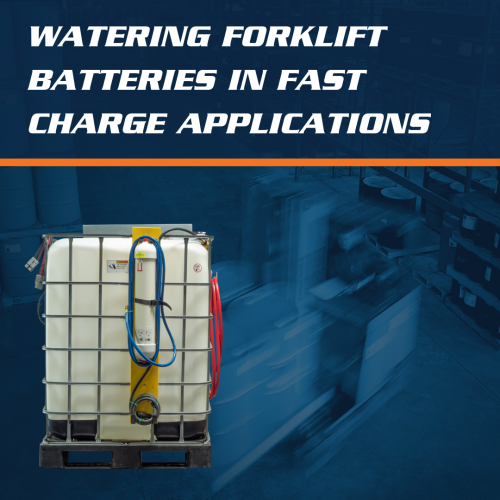We use cookies to make your experience better. To comply with the new e-Privacy directive, we need to ask for your consent to set the cookies. Learn more.
Watering Forklift Batteries in Fast Charge Applications

First off, battery fleet management systems in traditional battery rooms ensure that all batteries remain on an adequate watering and maintenance schedule. These systems are much more difficult to implement with widespread charging stations.
Then there’s the issue of water supply. In a battery room, you can install an Integrated Watering System into stands themselves. With fast charge stations, you have to carry your water supply with you. Without a tank of adequate size, that can include lots of trips back and forth to the Water Deionizing System, adding considerable time and expense to a fairly routine maintenance task for forklift batteries.
Here are a few tips to help keep your fast charge facility up to date on battery watering schedules:
- Water batteries at the same time every week. For fast charge batteries, this could be upon completion of the equalization charge. Or it might simply be the same day every week, preferably at a time when none of the forklifts are in use, so that a single operator can water all the batteries without a complicated schedule.
- Always use distilled water in your fast charge batteries. Tap water contains minerals and other particles that damage battery plates. While some users purchase large volumes of bottled water just for their batteries, this is an expensive proposition over time. It is more cost-effective to install a Water Deionizing System, which removes impurities with a replaceable filtering cartridge. Simply fill your watering tank from the Water Deionizing System’s hose before heading out to fill battery cells.
- Choose forklift batteries with a single-point watering system. One of the great advantages of opportunity charging is that you will rarely have to remove forklift batteries. However, in order to water batteries while they’re installed in the lift truck, they will usually require single-point watering systems.
- Use a tank that can carry enough purified water to fill all the batteries on the run. As mentioned above, efficiency depends on making a single trip to water forklift batteries across the entire facility. You can only accomplish this with a large enough tank — which then presents the challenge of transporting such a volume of water across the area.
The BHS Battery Watering and Filling System Tank (FST-330) was designed just for this activity. It’s a 330-gallon water supply that travels via pallet jack or lift truck. Fork pockets allow users to carry all the purified water they’ll need across great distances, without creating ergonomic risks.
A frame-mounted pump makes it easy to connect the water supply to batteries, fill them to the precise level required, then move onto the next lift truck. With a Water Deionizing System, an FST-330 mounted on a pallet jack or forklift, and a predictable watering schedule, every user of fast charge systems can keep batteries maintained and ready to work for as long as possible.
References:
Kempfer, Lisa. “Fast Chargers Power Up Lift Trucks.” MHLNews. Informa USA, INc., 1 Apr. 2006. Web. 13 Aug. 2019.
McLeod, Scott. “Forklift Fast Charging: The Positives and Negatives.” MHLNews. Informa USA, Inc., 1 Nov. 2010. Web. 13 Aug. 2019.
